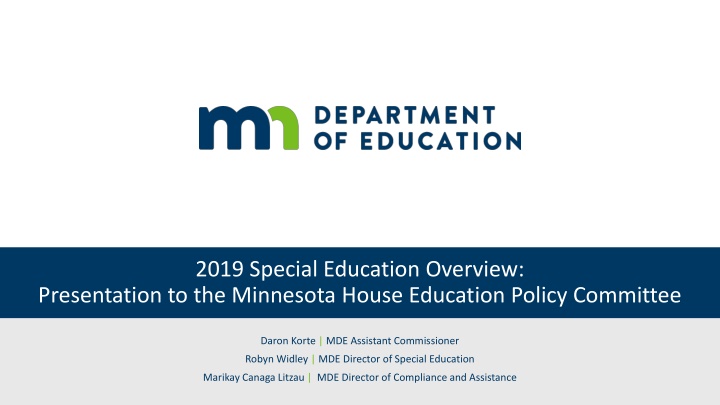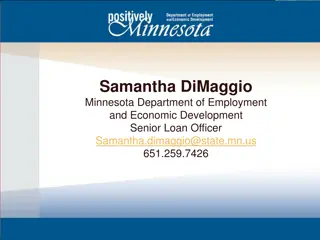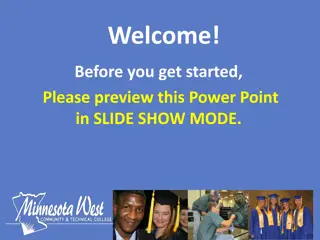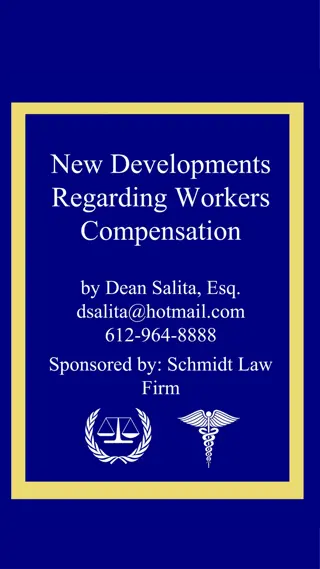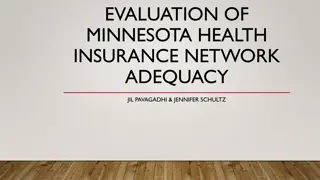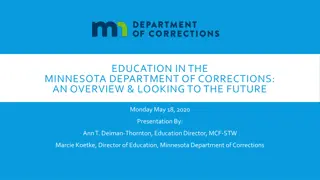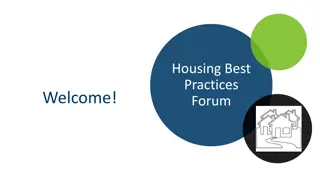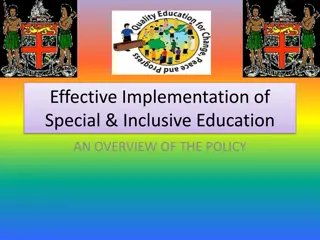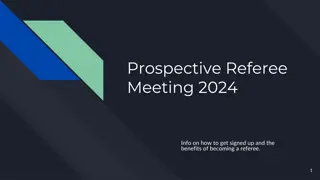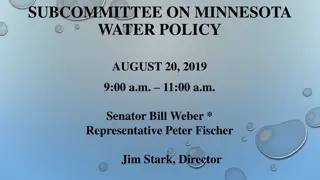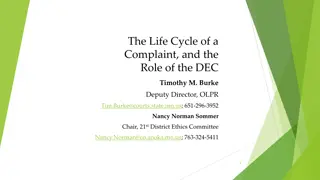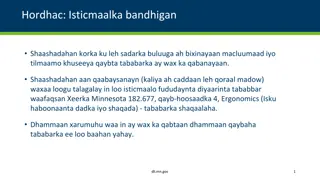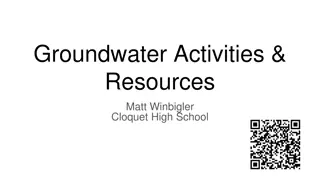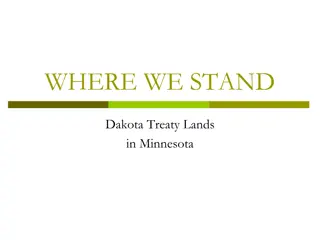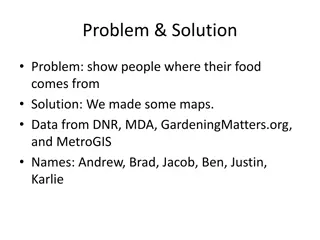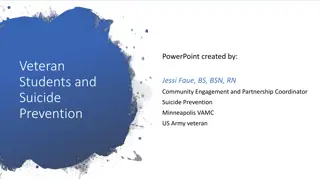Special Education Overview Presentation to Minnesota House Education Policy Committee
Presentation to the Minnesota House Education Policy Committee on Special Education Overview, including information on the Individuals with Disabilities Education Act (IDEA), IDEA Part B and Part C services, and guidelines for children with disabilities. The presentation covers key aspects such as free appropriate public education, individualized education programs, and services for infants and toddlers with disabilities.
Uploaded on Sep 16, 2024 | 4 Views
Download Presentation

Please find below an Image/Link to download the presentation.
The content on the website is provided AS IS for your information and personal use only. It may not be sold, licensed, or shared on other websites without obtaining consent from the author.If you encounter any issues during the download, it is possible that the publisher has removed the file from their server.
You are allowed to download the files provided on this website for personal or commercial use, subject to the condition that they are used lawfully. All files are the property of their respective owners.
The content on the website is provided AS IS for your information and personal use only. It may not be sold, licensed, or shared on other websites without obtaining consent from the author.
E N D
Presentation Transcript
2019 Special Education Overview: Presentation to the Minnesota House Education Policy Committee Daron Korte | MDE Assistant Commissioner Robyn Widley | MDE Director of Special Education Marikay Canaga Litzau | MDE Director of Compliance and Assistance
Special Education Overview Robyn Widley Director of Special Education 9/16/2024 Leading for educational excellence and equity, every day for every one. | education.mn.gov 2
Individuals with Disabilities Education Act IDEA Federal legislation to ensure that students with disabling conditions receive a free and appropriate public education to meet their unique needs. Last reauthorized in 2004. Federal law that includes accompanying regulations to provide guidance to state. Citations: 20 USCS 1400 et seq. 34 C.F.R. 300 et seq. 30 C.F.R. 303 et seq. 9/16/2024 Leading for educational excellence and equity, every day for every one. | education.mn.gov 3
IDEA Part B and Part C Part B Part C Includes educational funding and guidelines for children with disabilities ages 3 to 21. Provides guidelines concerning funding and services for children with disabilities and/or at risk conditions from birth to 3 years of age. 9/16/2024 Leading for educational excellence and equity, every day for every one. | education.mn.gov 4
Part B Services Part B includes requirements related to child find, eligibility, and development of an Individualized Education Program that provide: Free Appropriate Public Education (FAPE)in the least restrictive environment (LRE), also known as most integrated setting. Instruction to enable students with disabilities to be involved in and make progress in grade level curriculum. 9/16/2024 Leading for educational excellence and equity, every day for every one. | education.mn.gov 5
Part C Services Programming and services for infants and toddlers with disabilities ages birth to 3 and their families. Doctors or parents can make referrals through Help Me Grow MN. Specific services can be provided through an Individualized Family Service Plan (IFSP). 9/16/2024 Leading for educational excellence and equity, every day for every one. | education.mn.gov 6
Students with Disabilities 13 categories are used to identify children with disabilities ages birth through 21 in Minnesota as required in IDEA and Minnesota Rules 3525.1325 3525.1352. Children are served from Birth age 2 (Part C) and from 3 21 (Part B). 9/16/2024 Leading for educational excellence and equity, every day for every one. | education.mn.gov 7
13 Categorical Disabilities by Percent of Child Count Primary Disability Classification 2018-19 Count Percent of 2018-19 Child Count Specific Learning Disability 33,834 22.9% Speech or Language Impaired 22,857 15.5% Autism Spectrum Disorder 20,485 13.9% Other Health Disabilities 20,056 13.6% Developmental Delay 19,390 13.1% Emotional or Behavioral Disorders 16,814 11.4% Developmental Cognitive Disability Mild/Moderate 5,481 3.7% Deaf or Hard of Hearing 2,544 1.7% Developmental Cognitive Disability Severe/Profound 1,900 1.3% Physically Impaired 1,635 1.1% Severely Multiply Impaired 1,527 1.0% Blind or Visually Impaired 502 0.3% Traumatic Brain Injury 462 0.3% 9/16/2024 DeafBlind Leading for educational excellence and equity, every day for every one. | education.mn.gov 8 118 0.1%
Students with Disabilities as Percent of K-12 Enrollment 2014-2018 9
Students with DisabilitiesTotal Child Count, Birth to 21 2014-2018 10
Child Count by Area of DisabilityBirth to 21 2014-2018 Minnesota Child Count Ages 0-21 Disability Distribution 40,000 35,000 Specific Learning Disabilities 30,000 25,000 Speech or Language Impaired Autism Spectrum Disorder 20,000 Other Health Disabilities Developmental Delay Emotional or Behavioral Disorders 15,000 10,000 Developmental Cognitive Disabilities All Low Incidence 5,000 0 2013-14 2014-15 2015-16 2016-17 2017-18 2018-19 11 School Year
MDE Special Education Division Each of the current units in the Special Education Division provide training, information and resources, policy development and technical assistance to districts and other stakeholders through a variety of projects and grants. These activities help with local planning and service delivery, program implementation, program evaluation and problem solving centered around positive outcomes for students and improved results. 9/16/2024 Leading for educational excellence and equity, every day for every one. | education.state.mn.us 12
Key Activities Regional Low Incidence Facilitator Projects and Statewide Low Incidence Grant Activities Special Education Workforce Planning and Coordination Assistive Technology Teams Minnesota DeafBlind Project State Personnel Development Grant (SPDG) Minnesota Olmstead Plan Third Party Funding with Medical Assistance and Private Insurance for Health Related Services For students on IEPs Coordinated with Department of Human Services Federal Reporting State Systemic Improvement Planning and Reporting: Focusing on graduation rates for student with disabilities who are American Indian and/or Black Positive Behavioral Interventions and Supports (PBIS) initiative Alternative Delivery of Specialized Instructional Services (ADSIS) program Dyslexia Technical Assistance and Support 9/16/2024 Leading for educational excellence and equity, every day for every one. | education.state.mn.us 13
Stakeholders State agency partners including: Department of Human Services (DHS) Department of Health (MDH) Department of Corrections (DOC) Minnesota Rehabilitation Services Professional Educator Licensing and Standards Board (PELSB) Minnesota Olmstead Implementation Office and Subcabinet Legislators and staff MN school superintendents, business officials and transportation directors Special education directors and special education teachers School board members (districts, charter schools, cooperatives) Education organization directors and staff (MN School Boards Assoc., Education MN, MN Rural Education Assoc., Assoc. of Metropolitan School Districts) MN Administrators for Special Education (MASE) and MN Association of School Administrators (MASA) Advocacy organizations (PACER, ARC, NAMI) Students and parents General public 9/16/2024 Leading for educational excellence and equity, every day for every one. | education.state.mn.us 14
Individualized Education Program and Due Process Marikay Canaga Litzau Director of Compliance and Assistance 9/16/2024 Leading for educational excellence and equity, every day for every one. | education.mn.gov 15
The Purpose of the Individuals with Disabilities Education Act (IDEA) The purpose of IDEA is to ensure that all children with disabilities have available to them a free and appropriate public education (FAPE) that emphasizes special education and related services designed to meet their unique needs and prepare them for further education, employment and independent living. 34 C.F.R. 300.1(a) Leading for educational excellence and equity, every day for every one. | education.state.mn.us 16
Special Education Process 9/16/2024 17
Initial Eligibility for Special Education The evaluation team determines if the student is a child with a disability, as described in federal and state law, and identifies the student s educational needs. 34 C.F.R. 300.306 through 300.311 Minn. R. 3525.1325 through 3525.1354 A student must meet the specific criteria for one (or more) of the disability categories outlined in law. 18
The IEP Process and Due Process Requirements Determining Eligibility: Parent and district discuss the results and then an individualized education program (IEP) team meeting is held (it can be held at same time as the eligibility meeting). 9/16/2024 Leading for educational excellence and equity, every day for every one. | education.mn.gov 19
IEP Team membership IEP Team General Education teacher, special education teacher, administrative designee, parent, others invited as appropriate, including the student. The members have the knowledge and expertise to explain the assessment information, understand the general education curriculum, and have expertise in the area of special education. An administrative designee is required and that person must have the authority to commit district resources. 9/16/2024 Leading for educational excellence and equity, every day for every one. | education.mn.gov 20
Due Process Requirements IEP Team Meeting and Membership: The District must schedule the meeting at a mutually agreed upon time and place and inform parents of the meeting to ensure that at least one parent is able to participate. The IEP team must meet the state and federal requirements for membership. 9/16/2024 Leading for educational excellence and equity, every day for every one. | education.mn.gov 21
Major IEP Components A description of the student s present levels of academic achievement and functional performance. This must include a statement of how the student s disability affects the student s involvement and progress in the general education curriculum. Measurable annual goals and short term objectives/benchmarks (academic and functional). They must be designed to meet the student s needs to enable the student to be involved in and make progress in the general education curriculum. 9/16/2024 Leading for educational excellence and equity, every day for every one. | education.mn.gov 22
IEP Components Progress Reporting Description of when and how progress reporting will occur, Description of how progress on IEP goals will be measured, and Describe the special education and related services the student will receive. 9/16/2024 Leading for educational excellence and equity, every day for every one. | education.mn.gov 23
Major IEP Components Continued Supplementary Aids and Services (program modifications, accommodations and supports). Least Restrictive Environment (LRE): How often will the student not be with nondisabled peers during general education curriculum, and extracurricular and nonacademic activities. When services are projected to begin, and the anticipated frequency, location and duration of the services and modifications. 9/16/2024 Leading for educational excellence and equity, every day for every one. | education.mn.gov 24
IEP Components included if appropriate for the student State and districtwide assessment - appropriate accommodation(s) needed for or a statement of why a student is unable to take the regular state or district wide assessment and why particular selected alternative assessment is appropriate. Transfer of Rights by age of majority (not later than one year before the student reaches the age of majority under state law) - inform the student of their rights under IDEA Part B. . 9/16/2024 Leading for educational excellence and equity, every day for every one. | education.mn.gov 25
Transition Services Component Transition services to be provided during grade nine. Produce a results-oriented IEP process; Focus on improving the academic and functional achievement of the child; Facilitate movement from school to post-school activities; Based on child's needs. 26
Due Process Requirements: Prior Written Notice The District provides the parent with a prior written notice and proposed IEP - the parent must consent to an initial IEP. If it is a revised IEP, the notice informs the parent the IEP will go into effect 14 calendar days from the date it was sent to the parent. If the parent objects to the proposed IEP the District must set up a conciliation conference unless the parent refuses. Parent may request mediation, facilitated team meeting or another IEP meeting. 9/16/2024 Leading for educational excellence and equity, every day for every one. | education.mn.gov 27
In what areas do Minnesota rules and statutes exceed Federal IDEA Requirements? See Handout: Section 608 Memorandum 9/16/2024 Leading for educational excellence and equity, every day for every one. | education.mn.gov 28
Thank you! Marikay Canaga Litzau Robyn Widley Daron Korte marikay.litzau@state.mn.us robyn.widley@state.mn.us daron.korte@state.mn.us 651.582.8459 651.582.1143 651.582.8215 9/16/2024 29
